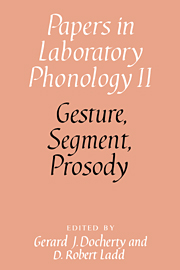Book contents
- Frontmatter
- Contents
- List of contributors
- Acknowledgments
- Introduction
- Section A Gesture
- 1 An introduction to task dynamics
- 2 “Targetless” schwa: an articulatory analysis
- 3 Prosodic structure and tempo in a sonority model of articulatory dynamics
- 4 Lenition of |h| and glottal stop
- 5 On types of coarticulation
- Section B Segment
- Section C Prosody
- Appendix 1 The test phrases (bold type) of experiment 1 in the context in which they were read
- Appendix 2 The distractors (bold type) of experiment 1 in the context in which they were read
- Appendix 3 The test sentences of experiment 2. The test words are in bold type
- Appendix 4 The distractor sentences of experiment 2. The distractors are in bold type
- References
- Name index
- Subject index
1 - An introduction to task dynamics
from Section A - Gesture
Published online by Cambridge University Press: 18 December 2009
- Frontmatter
- Contents
- List of contributors
- Acknowledgments
- Introduction
- Section A Gesture
- 1 An introduction to task dynamics
- 2 “Targetless” schwa: an articulatory analysis
- 3 Prosodic structure and tempo in a sonority model of articulatory dynamics
- 4 Lenition of |h| and glottal stop
- 5 On types of coarticulation
- Section B Segment
- Section C Prosody
- Appendix 1 The test phrases (bold type) of experiment 1 in the context in which they were read
- Appendix 2 The distractors (bold type) of experiment 1 in the context in which they were read
- Appendix 3 The test sentences of experiment 2. The test words are in bold type
- Appendix 4 The distractor sentences of experiment 2. The distractors are in bold type
- References
- Name index
- Subject index
Summary
Motivation and overview
The aim of this paper is to describe for the nonspecialist the main features of task dynamics so that research that uses it can be understood and evaluated more easily. Necessarily, there are some omissions and simplifications. More complete accounts can be found in the references cited in the text, especially Saltzman (1986) and Saltzman and Munhall (1989); Browman and Goldstein (1989, 1990) offer clear descriptions that focus more on the phonologically relevant aspects than the mathematical details. The task-dynamic model is being developed at the same time as it is being used as a research tool. Consistent with this paper's purpose as a general introduction rather than a detailed critique, it mainly describes the current model, and tends not to discuss intentions for how the model should ultimately work or theoretical differences among investigators.
Task dynamics is a general model of skilled movement control that was developed originally to explain nonspeech tasks such as reaching and standing upright, and has more recently been applied to speech. It is based on general biological and physical principles of coordinated movement, but is couched in dynamical rather than anatomical or physiological terms. It involves a relatively radical approach that is more abstract than many more traditional systems, and has proved to be a particularly useful way of analyzing speech production, partly because it breaks complex movements down into a set of functionally independent tasks.
- Type
- Chapter
- Information
- Gesture, Segment, Prosody , pp. 9 - 25Publisher: Cambridge University PressPrint publication year: 1992
- 13
- Cited by

